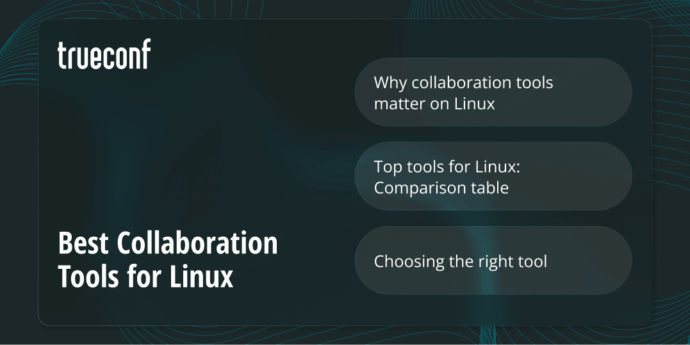Best Collaboration Tools for Linux: Secure and Scalable Solutions

In 2021, 79 % of workers globally were using digital collaboration tools — up from 55 % in 2019, testifying to how essential these platforms have become in modern workflows. While most platforms are designed with cross-platform compatibility in mind, Linux users often search for solutions that not only integrate smoothly into their workflow but also respect the open-source philosophy. Fortunately, there are a variety of collaboration tools available for Linux that support everything from messaging to project management.
Meanwhile, the Linux software ecosystem is projected to grow from USD 6.3 billion in 2025 to USD 14.5 billion by 2032, indicating rising demand for Linux-native applications.
Why Collaboration Tools Matter on Linux
Linux powers countless servers, developer environments, and enterprise systems worldwide. In fact, over 96% of the world’s top 1 million web servers run on Linux, and 90% of all cloud infrastructure operates on Linux-based systems. With this dominance, teams that rely on Linux need dependable communication and coordination platforms to keep projects running smoothly and securely.
Collaboration tools for Linux bring several advantages:
- Seamless integration with Linux-friendly workflows and developer ecosystems
- Strong security and privacy options, critical for the 78% of enterprises that cite security as their top reason for adopting Linux
- Lightweight performance suitable for developers, administrators, and large-scale environments where efficiency matters
- Flexibility through APIs, plugins, and community-driven support, ensuring customization for different industries and organizational needs.
TrueConf for Linux!
Meet for up to 1,000 users, chat, and collaborate just one place.
Top Collaboration Tools for Linux
1. TrueConf
TrueConf delivers a robust, enterprise-grade video conferencing and collaboration platform designed to be deployed on servers (including Linux) or within closed networks. It supports UltraHD video, secure messaging, and a full collaboration suite while preserving data sovereignty. The system is suitable for organizations demanding high control over communication infrastructure.
Key Features:
- UltraHD (4K) video conferencing and multipoint support (e.g. up to 49 on-screen participants, more in role-based mode)
- End-to-end encryption, secure on-premises and LAN/VPN operation, and restricted IP access for privacy
- AI features like smart assistant hints, adaptive layouts, and support for transcription/automated tasks
- Integration with calendars, directory services (LDAP/Active Directory), and federation of multiple servers
- Conference management tools: waiting rooms, PINs/IDs, layout control, banning/unbanning participants, streaming to CDN
- Collaboration tools: screen sharing, file exchange, surveys, chat, whiteboard, remote control, annotation.
2. Rocket.Chat
Rocket.Chat functions as a community-driven communication solution which may be locally deployed on Linux environments. It delivers instant conversations, document transfer, voice conferencing, plus interconnected server networks, granting extensive oversight over resources and operations.
Key Features:
- Locally managed installation with complete information ownership
- Comprehensive encryption alongside role-specific privileges
- Two-factor verification with regulatory compliance backing
- Extension and plugin framework supporting integrations
- Linked servers enabling cross-organization collaboration.
3. Mattermost
Mattermost represents a widely adopted self-managed substitute to Slack, designed for DevOps specialists and technical groups. It enables document exchange, threaded discussions, extensions, and comprehensive connectivity with software pipelines—fully operable on Linux systems.
Key Features:
- Self-managed installation across Linux infrastructures
- Connections with DevOps plus CI/CD processes
- Organized discussions, file uploads, and enhanced searching
- Extension and plugin capabilities for adaptability
- Role-driven permissions and reinforced protection measures.
4. Nextcloud
Nextcloud serves as more than a document repository tool, functioning instead as a comprehensive collaboration platform. Using Nextcloud, Linux professionals may handle files, converse through chat, organize virtual meetings, coordinate calendars, and additional tasks — all supported within a single self-managed environment.
Key Features:
- Locally hosted environment offering file exchange plus communication features
- Fully encrypted voice alongside video conferencing sessions
- Cooperative document editing integrated with schedules and contacts
- Availability across desktop and mobile clients
- Connectivity with the wider Nextcloud application ecosystem.
5. Jitsi Meet
Jitsi Meet stands as a cost-free, community-driven conferencing platform. Administrators may deploy personal Jitsi instances on Linux machines, enabling protected video sessions, desktop sharing, plus essential teamwork features without demanding user registrations.
Key Features:
- Protected conferencing service utilizing encryption
- Desktop sharing, meeting capture, and live chat
- Web-based entry requiring no prior registration
- Capability for complete self-management on Linux infrastructures.
6. Zulip
Zulip functions as a messaging platform featuring a distinctive threaded dialogue approach which assists teams in maintaining structured discussions. It remains community-driven, operates with Linux devices, and connects efficiently with engineering utilities.
Key Features:
- Thread-focused, subject-oriented communication framework
- Locally hosted or cloud-enabled deployment choices
- Broad compatibility and integration with outside applications
- Indexed archives plus extended message preservation
- LDAP integration alongside authentication capabilities.
Collaboration Tools for Linux: Comparison Table
|
Tool |
Hosting / Deployment Model |
Best Use Case |
Linux Compatibility |
|---|---|---|---|
|
TrueConf |
On-premises, can run in closed network |
Secure video conferencing + unified communications for public sectors |
Clients available on Linux; full server supports Linux environments |
|
Rocket.Chat |
Self-hosted (Docker, Kubernetes, VPS) or cloud hosted |
Secure messaging, file sharing, chat for teams wanting data sovereignty |
Desktop and client apps for Linux; server easily deployable on Linux |
|
Mattermost |
Self-hosted or cloud |
Developer teams needing deep integrations and control |
Native Linux server support; Linux clients available |
|
Nextcloud |
Self-hosted |
All-in-one collaboration (docs, chat, calendar) behind your firewall |
Runs on Linux servers; web + Linux clients |
|
Jitsi Meet |
Self-hosted or cloud |
Secure, no-frills video conferencing |
Can be deployed on Linux servers; clients support Linux via browser or app |
|
Zulip |
Self-hosted or cloud |
Threaded chat for technical or distributed teams |
Linux server support and Linux client apps. |
Choosing the Right Tool
Choosing a collaboration platform for Linux involves more than a technological choice — it determines how groups coordinate, distribute information, and remain efficient. The proper solution must connect with an organization’s objectives, whether that means protection, adaptability, or simplicity of introduction. These represent the essential aspects to evaluate:
Hosting Model: Self-Hosted vs. Cloud
Self-managed options provide institutions and enterprises complete oversight of resources and infrastructure. They prove suitable for entities under rigorous privacy policies or compliance standards. Cloud-based alternatives, by comparison, reduce administrative burden and deliver simpler scalability — yet they frequently depend on third-party environments and providers.
Security and Compliance Needs
Public agencies, corporations, and nonprofits frequently function under demanding privacy frameworks (including GDPR, HIPAA, or FedRAMP). An effective collaboration service should feature comprehensive encryption, permission-based access, and resilient authentication. Linux-supported platforms such as Rocket.Chat, Mattermost, and TrueConf are particularly respected for meeting these obligations.
Integration with Existing Workflows
Any collaboration system must integrate smoothly with tools already deployed, such as CRMs, workflow trackers, messaging servers, or software pipelines. Effective integration eliminates wasted transitions between applications and helps professionals remain concentrated on core responsibilities.
Ease of Use for Technical and Non-Technical Staff
Linux is favored by programmers and technology specialists, though many colleagues are not advanced users. The selected platform needs to remain straightforward for non-technical staff while offering advanced tuning options for IT administrators. Clear interfaces, reduced training burdens, and thorough guides accelerate adoption significantly.
Scalability and Long-Term Flexibility
With organizational expansion, platforms must support larger teams, heavier workloads, and broader integrations. A scalable service avoids expensive system migrations later and guarantees long-term resilience. Linux-compatible solutions are often adjustable and extendable, evolving naturally alongside institutional requirements.
Conclusion
Linux professionals rarely have to sacrifice effective collaboration. From community-driven platforms enabling private deployment to enterprise-level solutions integrating within worldwide infrastructures, the Linux environment provides an extensive variety of resources designed to keep groups unified, efficient, and protected. The optimal selection ultimately relies upon harmonizing transparency, authority, and practicality in order to satisfy organizational requirements.
About the Author
Olga Afonina is a technology writer and industry expert specializing in video conferencing solutions and collaboration software. At TrueConf, she focuses on exploring the latest trends in collaboration technologies and providing businesses with practical insights into effective workplace communication. Drawing on her background in content development and industry research, Olga writes articles and reviews that help readers better understand the benefits of enterprise-grade communication.




Follow us on social networks